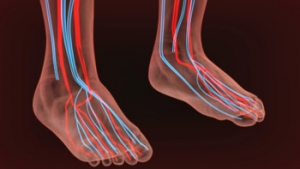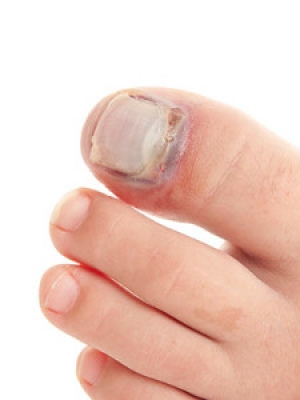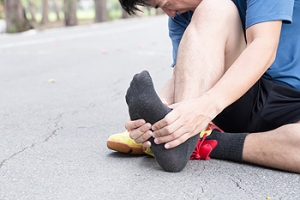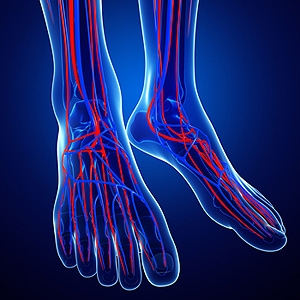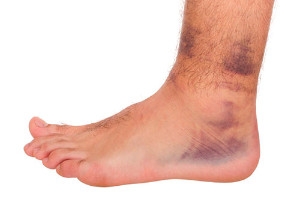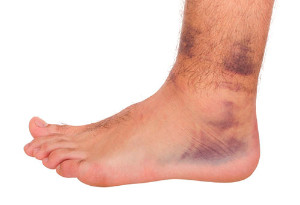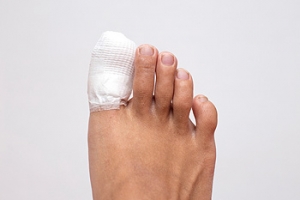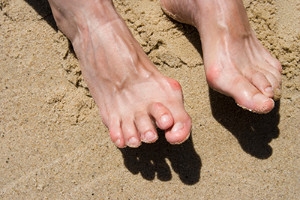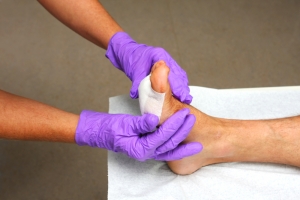Super User
Peripheral Neuropathy
Peripheral neuropathy is a result of dam age done to the nerves outside of the brain and spinal cord. This will often cause weakness, numbness, and pain in the feet. This type of neuropathy can result from traumatic injuries, infections, metabolic problems, inherited causes and an exposure to toxins. The symptoms include muscle weakness, a lack of coordination and falling, sharp burning pain, numbness and extreme sensitivity to touch. People who have diabetes, kidney and thyroid disorders, vitamin deficiencies and have a history of alcohol abuse are at an increased risk to acquire peripheral neuropathy. Complications that can arise are infections, burns and skin trauma and an increased propensity to falls. The risk for peripheral neuropathy can be decreased by exercising regularly, avoiding factors that may cause nerve damage and eating a diet that is rich in fruits, vegetables and protein. If you feel that you may be at risk for peripheral neuropathy, it is advised to consult with a podiatrist.
age done to the nerves outside of the brain and spinal cord. This will often cause weakness, numbness, and pain in the feet. This type of neuropathy can result from traumatic injuries, infections, metabolic problems, inherited causes and an exposure to toxins. The symptoms include muscle weakness, a lack of coordination and falling, sharp burning pain, numbness and extreme sensitivity to touch. People who have diabetes, kidney and thyroid disorders, vitamin deficiencies and have a history of alcohol abuse are at an increased risk to acquire peripheral neuropathy. Complications that can arise are infections, burns and skin trauma and an increased propensity to falls. The risk for peripheral neuropathy can be decreased by exercising regularly, avoiding factors that may cause nerve damage and eating a diet that is rich in fruits, vegetables and protein. If you feel that you may be at risk for peripheral neuropathy, it is advised to consult with a podiatrist.
Neuropathy
Neuropathy can be a potentially serious condition, especially if it is left undiagnosed. If you have any concerns that you may be experiencing nerve loss in your feet, consult with Dr. Anna Petrov from Family Foot & Ankle Care. Our doctor will assess your condition and provide you with quality foot and ankle treatment for neuropathy.
What Is Neuropathy?
Neuropathy is a condition that leads to damage to the nerves in the body. Peripheral neuropathy, or neuropathy that affects your peripheral nervous system, usually occurs in the feet. Neuropathy can be triggered by a number of different causes. Such causes include diabetes, infections, cancers, disorders, and toxic substances.
Symptoms of Neuropathy Include:
- Numbness
- Sensation loss
- Prickling and tingling sensations
- Throbbing, freezing, burning pains
- Muscle weakness
Those with diabetes are at serious risk due to being unable to feel an ulcer on their feet. Diabetics usually also suffer from poor blood circulation. This can lead to the wound not healing, infections occurring, and the limb may have to be amputated.
Treatment
To treat neuropathy in the foot, podiatrists will first diagnose the cause of the neuropathy. Figuring out the underlying cause of the neuropathy will allow the podiatrist to prescribe the best treatment, whether it be caused by diabetes, toxic substance exposure, infection, etc. If the nerve has not died, then it’s possible that sensation may be able to return to the foot.
Pain medication may be issued for pain. Electrical nerve stimulation can be used to stimulate nerves. If the neuropathy is caused from pressure on the nerves, then surgery may be necessary.
If you have any questions, please feel free to contact one of our offices located in Wheeling and Chicago, IL . We offer the newest diagnostic and treatment technologies for all your foot care needs.
Overview of Plantar Warts
 Plantar warts develop on the bottom of the foot. They are caused by human papilloma virus, better known as HPV. If you believe you have developed a plantar wart, refrain from picking at it as the virus can be spread through touch and scratch. While anyone is prone to developing these types of warts, they most typically affect children, teens, and young adults. When in your body, HPV sets off the multiplication of epidermal cells that leads to the formation of warts on the feet. Plantar warts tend to develop on the heel or weight-bearing parts of soles. They will often grow inward, exposing sensitive tissue and triggering pain and bleeding. If the wart is small and non-intrusive, it can be treated through home remedies such as over-the-counter (OTC) treatments. Most OTC treatments contain salicylic acid and are applied topically to the wart. If the wart is bigger in size, in-office procedures may deliver faster and safer results. The in-office treatments include cryotherapy, immunotherapy and regular surgery. Plantar warts can be prevented best by covering your feet in places where people walk barefoot and changing your shoes and socks regularly to avoid the spread of the virus. Washing and drying the feet thoroughly with the use of talcum powder to help absorb excess moisture and perspiration is also a prevention recommendation. If you are developing plantar warts, it is important to see a podiatrist for the best treatment option.
Plantar warts develop on the bottom of the foot. They are caused by human papilloma virus, better known as HPV. If you believe you have developed a plantar wart, refrain from picking at it as the virus can be spread through touch and scratch. While anyone is prone to developing these types of warts, they most typically affect children, teens, and young adults. When in your body, HPV sets off the multiplication of epidermal cells that leads to the formation of warts on the feet. Plantar warts tend to develop on the heel or weight-bearing parts of soles. They will often grow inward, exposing sensitive tissue and triggering pain and bleeding. If the wart is small and non-intrusive, it can be treated through home remedies such as over-the-counter (OTC) treatments. Most OTC treatments contain salicylic acid and are applied topically to the wart. If the wart is bigger in size, in-office procedures may deliver faster and safer results. The in-office treatments include cryotherapy, immunotherapy and regular surgery. Plantar warts can be prevented best by covering your feet in places where people walk barefoot and changing your shoes and socks regularly to avoid the spread of the virus. Washing and drying the feet thoroughly with the use of talcum powder to help absorb excess moisture and perspiration is also a prevention recommendation. If you are developing plantar warts, it is important to see a podiatrist for the best treatment option.
Plantar warts can be very uncomfortable. If you need your feet checked, contact Dr. Anna Petrov from Family Foot & Ankle Care. Our doctor will assist you with all of your foot and ankle needs.
About Plantar Warts
Plantar warts are the result of HPV, or human papillomavirus, getting into open wounds on the feet. They are mostly found on the heels or balls of the feet.
While plantar warts are generally harmless, those experiencing excessive pain or those suffering from diabetes or a compromised immune system require immediate medical care. Plantar warts are easily diagnosed, usually through scraping off a bit of rough skin or by getting a biopsy.
Symptoms
- Lesions on the bottom of your feet, usually rough and grainy
- Hard or thick callused spots
- Wart seeds, which are small clotted blood vessels that look like little black spots
- Pain, discomfort, or tenderness of your feet when walking or standing
Treatment
- Freezing
- Electric tool removal
- Laser Treatment
- Topical Creams (prescription only)
- Over-the-counter medications
To help prevent developing plantar warts, avoid walking barefoot over abrasive surfaces that can cause cuts or wounds for HPV to get into. Avoiding direct contact with other warts, as well as not picking or rubbing existing warts, can help prevent the further spread of plantar warts. However, if you think you have developed plantar warts, speak to your podiatrist. He or she can diagnose the warts on your feet and recommend the appropriate treatment options.
If you have any questions please feel free to contact one of our offices located in Wheeling and Chicago, IL . We offer the newest diagnostic and treatment technologies for all your foot and ankle needs.
Broken Toe Facts
Broken toes are of ten caused by trauma or injury. Repetitive movements can cause a break to turn into a stress or hairline fracture. Symptoms of a broken toe include pain, swelling, stiffness, bruising, and difficulty walking. The most common causes of a broken toe are stubbing the toe and dropping a heavy object on it. When compared to other parts of the foot, the toes are the most likely to get injured due to their location at the front of the feet. It is important to seek an opinion after the injury has occurred in order to ensure proper treatment and healing can take place. In order to diagnose whether it is a break or not, a doctor will ask questions of how the injury occurred and they will also administer an X-ray to confirm it. If you feel that you have sustained a broken toe, it is advised to consult with a podiatrist.
ten caused by trauma or injury. Repetitive movements can cause a break to turn into a stress or hairline fracture. Symptoms of a broken toe include pain, swelling, stiffness, bruising, and difficulty walking. The most common causes of a broken toe are stubbing the toe and dropping a heavy object on it. When compared to other parts of the foot, the toes are the most likely to get injured due to their location at the front of the feet. It is important to seek an opinion after the injury has occurred in order to ensure proper treatment and healing can take place. In order to diagnose whether it is a break or not, a doctor will ask questions of how the injury occurred and they will also administer an X-ray to confirm it. If you feel that you have sustained a broken toe, it is advised to consult with a podiatrist.
A broken toe can be very painful and lead to complications if not properly fixed. If you have any concerns about your feet, contact Dr. Anna Petrov from Family Foot & Ankle Care. Our doctor will treat your foot and ankle needs.
What to Know About a Broken Toe
Although most people try to avoid foot trauma such as banging, stubbing, or dropping heavy objects on their feet, the unfortunate fact is that it is a common occurrence. Given the fact that toes are positioned in front of the feet, they typically sustain the brunt of such trauma. When trauma occurs to a toe, the result can be a painful break (fracture).
Symptoms of a Broken Toe
- Throbbing pain
- Swelling
- Bruising on the skin and toenail
- The inability to move the toe
- Toe appears crooked or disfigured
- Tingling or numbness in the toe
Generally, it is best to stay off of the injured toe with the affected foot elevated.
Severe toe fractures may be treated with a splint, cast, and in some cases, minor surgery. Due to its position and the pressure it endures with daily activity, future complications can occur if the big toe is not properly treated.
If you have any questions please feel free to contact one of our offices located in Wheeling and Chicago, IL . We offer the newest diagnostic and treatment technologies for all your foot and ankle needs.
Poorly Fitting Shoes May Cause Foot Pain
 If foot pain is present, it can cause limited mobility. The foot is comprised of numerous bones, and these are connected by ligaments, muscles and tendons. Pain and injury may occur as a result of consistent weight the feet endure while accomplishing daily activities. This often happens if the foot does not function properly, and can become worse if poorly fitting shoes are worn. There are several different types of foot pain. If there is discomfort on the heel of the foot, a heel spur may be present. This is a small growth on the heel bone, and mild relief can be obtained while resting and wearing shoe inserts. A bunion can cause considerable pain, and putting protective pads on the affected area may help in alleviating discomfort. If you have any type of foot pain, it is suggested to speak to a podiatrist who can properly treat any foot condition.
If foot pain is present, it can cause limited mobility. The foot is comprised of numerous bones, and these are connected by ligaments, muscles and tendons. Pain and injury may occur as a result of consistent weight the feet endure while accomplishing daily activities. This often happens if the foot does not function properly, and can become worse if poorly fitting shoes are worn. There are several different types of foot pain. If there is discomfort on the heel of the foot, a heel spur may be present. This is a small growth on the heel bone, and mild relief can be obtained while resting and wearing shoe inserts. A bunion can cause considerable pain, and putting protective pads on the affected area may help in alleviating discomfort. If you have any type of foot pain, it is suggested to speak to a podiatrist who can properly treat any foot condition.
Foot Pain
Foot pain can be extremely painful and debilitating. If you have a foot pain, consult with Dr. Anna Petrov from Family Foot & Ankle Care. Our doctor will assess your condition and provide you with quality foot and ankle treatment.
Causes
Foot pain is a very broad condition that could be caused by one or more ailments. The most common include:
- Bunions
- Hammertoes
- Plantar Fasciitis
- Bone Spurs
- Corns
- Tarsal Tunnel Syndrome
- Ingrown Toenails
- Arthritis (such as Gout, Rheumatoid, and Osteoarthritis)
- Flat Feet
- Injury (from stress fractures, broken toe, foot, ankle, Achilles tendon ruptures, and sprains)
- And more
Diagnosis
To figure out the cause of foot pain, podiatrists utilize several different methods. This can range from simple visual inspections and sensation tests to X-rays and MRI scans. Prior medical history, family medical history, and any recent physical traumatic events will all be taken into consideration for a proper diagnosis.
Treatment
Treatment depends upon the cause of the foot pain. Whether it is resting, staying off the foot, or having surgery; podiatrists have a number of treatment options available for foot pain.
If you have any questions, please feel free to contact one of our offices located in Wheeling and Chicago, IL . We offer the newest diagnostic and treatment technologies for all your foot care needs.
Read more about Foot PainPossible Methods to Improve Poor Circulation
 Poor circulation is a common ailment among many people. The symptoms that are typically associated with this condition often include cold feet and toes, a tingling or numbing sensation, or possibly swollen feet. People can develop poor circulation from a variety of reasons. Lack of exercise, poor eating habits, and smoking may all be linked to this condition. When healthy lifestyle changes are implemented, the benefits include additional energy which is a result of improved blood flow throughout the body. Many patients find it beneficial in performing a routine yoga practice, in addition to receiving massages. If you have poor circulation, it is suggested that you seek the counsel of a podiatrist who can guide you toward proper treatment.
Poor circulation is a common ailment among many people. The symptoms that are typically associated with this condition often include cold feet and toes, a tingling or numbing sensation, or possibly swollen feet. People can develop poor circulation from a variety of reasons. Lack of exercise, poor eating habits, and smoking may all be linked to this condition. When healthy lifestyle changes are implemented, the benefits include additional energy which is a result of improved blood flow throughout the body. Many patients find it beneficial in performing a routine yoga practice, in addition to receiving massages. If you have poor circulation, it is suggested that you seek the counsel of a podiatrist who can guide you toward proper treatment.
While poor circulation itself isn’t a condition; it is a symptom of another underlying health condition you may have. If you have any concerns with poor circulation in your feet contact Dr. Anna Petrov of Family Foot & Ankle Care. Our doctor will treat your foot and ankle needs.
Poor Circulation in the Feet
Peripheral artery disease (PAD) can potentially lead to poor circulation in the lower extremities. PAD is a condition that causes the blood vessels and arteries to narrow. In a linked condition called atherosclerosis, the arteries stiffen up due to a buildup of plaque in the arteries and blood vessels. These two conditions can cause a decrease in the amount of blood that flows to your extremities, therefore resulting in pain.
Symptoms
Some of the most common symptoms of poor circulation are:
- Numbness
- Tingling
- Throbbing or stinging pain in limbs
- Pain
- Muscle Cramps
Treatment for poor circulation often depends on the underlying condition that causes it. Methods for treatment may include insulin for diabetes, special exercise programs, surgery for varicose veins, or compression socks for swollen legs.
As always, see a podiatrist as he or she will assist in finding a regimen that suits you. A podiatrist can also prescribe you any needed medication.
If you have any questions, please feel free to contact one of our offices located in Wheeling and Chicago, IL . We offer the newest diagnostic and treatment technologies for all your foot care needs.
How to Treat Ankle Sprains
Ankle sprains are considered to be a common foot injury. Many people will experience this condition at some point in their lives, and pain and discomfort often accompanies this ailment. Research has indicated the importance of treating your ankle sprain as quickly as possible. This typically begins with resting and elevating the foot which may reduce any existing swelling. Mild relief can be found when compression is applied to the ankle and surrounding areas. This can be accomplished by wrapping the ankle in an elastic bandage, and making sure it feels comfortable. This can help to ensure proper circulation while the healing process takes place. If you have sprained your ankle, it is suggested to consult with a podiatrist who can properly treat this condition.
Ankle sprains are common but need immediate attention. If you need your feet checked, contact Dr. Anna Petrov from Family Foot & Ankle Care. Our doctor can provide the care you need to keep you pain-free and on your feet.
How Does an Ankle Sprain Occur?
Ankle sprains take place when the ligaments in your ankle are torn or stretched beyond their limits. There are multiple ways that the ankle can become injured, including twisting or rolling over onto your ankle, putting undue stress on it, or causing trauma to the ankle itself.
What Are the Symptoms?
- Mild to moderate bruising
- Limited mobility
- Swelling
- Discoloration of the skin (depending on severity)
Preventing a Sprain
- Wearing appropriate shoes for the occasion
- Stretching before exercises and sports
- Knowing your limits
Treatment of a Sprain
Treatment of a sprain depends on the severity. Many times, people are told to rest and remain off their feet completely, while others are given an air cast. If the sprain is very severe, surgery may be required.
If you have suffered an ankle sprain previously, you may want to consider additional support such as a brace and regular exercises to strengthen the ankle.
If you have any questions please feel free to contact one of our offices located in Wheeling and Chicago, IL . We offer the newest diagnostic and treatment technologies for all your foot and ankle needs.
Different Types of Running Shoes
 Research has indicated the most common form of running is done on roads. The hard ground may play havoc on the human body, and it is beneficial to wear running shoes that are correct for you. It is helpful to know how your foot strikes the ground. This is easily accomplished by looking at a current pair of running shoes and noticing where the sole is worn. Additionally, having good support in a shoe is important to consider if long distance running is preferred. When there is adequate cushioning in the shoe, it will be easier to run much more comfortably. Many runners have a recovery shoe, and this is worn after running a race, or if an injury to the foot has occurred. If you would like additional information about the different types of running shoes, it is suggested that you speak to a podiatrist who can answer any questions you may have.
Research has indicated the most common form of running is done on roads. The hard ground may play havoc on the human body, and it is beneficial to wear running shoes that are correct for you. It is helpful to know how your foot strikes the ground. This is easily accomplished by looking at a current pair of running shoes and noticing where the sole is worn. Additionally, having good support in a shoe is important to consider if long distance running is preferred. When there is adequate cushioning in the shoe, it will be easier to run much more comfortably. Many runners have a recovery shoe, and this is worn after running a race, or if an injury to the foot has occurred. If you would like additional information about the different types of running shoes, it is suggested that you speak to a podiatrist who can answer any questions you may have.
You should always make sure your running shoes fit properly in order to avoid injury. For more information, contact Dr. Anna Petrov from Family Foot & Ankle Care. Our doctor can provide the care you need to keep you pain-free and on your feet.
Choosing the Right Running Shoe for Your Foot Type
Improper shoe sizing can cause a myriad of problems for your feet. Shoes that don’t fit you properly can lead to muscular imbalances in your body, which can result in foot, knee, and hip injuries.
Tips for Finding the Right Running Shoe
- Make sure you have a thumb’s width of wiggle room between the end of your longest toe and the front of the shoe.
- There should be little to no slipping at the heel
- Don’t assume your size in one shoe brand will be your size in another
- Do not lace up your shoes too tightly
- Walk around in the store with your new shoes before you buy them
If you have any questions please feel free to contact our one of our offices located in Wheeling and Chicago, IL . We offer the newest diagnostic and treatment technologies for all your foot and ankle needs.
Possible Treatment of a Broken Toe
 The bones that exist in the toes are fragile and small, and may easily break if a heavy object is dropped on them. Patients may realize their toe may be broken if it appears to be crooked, or if an open wound occurs after the injury happens. Additional symptoms may include pain, difficulty in moving the toe, and swelling. Mild relief may be found while elevating the foot, which may help to decrease swelling. It is suggested to keep the foot as still as possible, and this may be accomplished by resting the foot frequently during the day. Taping the injured toe to the toe next to it may provide stability while the healing process occurs. If you feel you have broken your toe, it is suggested that you consult with a podiatrist who can properly diagnosis and treat this condition.
The bones that exist in the toes are fragile and small, and may easily break if a heavy object is dropped on them. Patients may realize their toe may be broken if it appears to be crooked, or if an open wound occurs after the injury happens. Additional symptoms may include pain, difficulty in moving the toe, and swelling. Mild relief may be found while elevating the foot, which may help to decrease swelling. It is suggested to keep the foot as still as possible, and this may be accomplished by resting the foot frequently during the day. Taping the injured toe to the toe next to it may provide stability while the healing process occurs. If you feel you have broken your toe, it is suggested that you consult with a podiatrist who can properly diagnosis and treat this condition.
Broken toes may cause a lot of pain and should be treated as soon as possible. If you have any concerns about your feet, contact Dr. Anna Petrov from Family Foot & Ankle Care. Our doctor will treat your foot and ankle needs.
What Is a Broken Toe?
A broken toe occurs when one or more of the toe bones of the foot are broken after an injury. Injuries such as stubbing your toe or dropping a heavy object on it may cause a toe fracture.
Symptoms of a Broken Toe
- Swelling
- Pain (with/without wearing shoes)
- Stiffness
- Nail Injury
Although the injured toe should be monitored daily, it is especially important to have a podiatrist look at your toe if you have severe symptoms. Some of these symptoms include worsening or new pain that is not relieved with medication, sores, redness, or open wounds near the toe.
If you have any questions, please feel free to contact one of our offices located in Wheeling and Chicago, IL . We offer the newest diagnostic and treatment technologies for all your foot care needs.
What Causes Hammertoe?
 If you notice your middle toes are bent in a downward position, you may have what is referred to as hammertoe. The second toe is typically affected, and it may resemble a hammer as a result of the way it is bent. The most common reasons for hammertoes to develop may be from wearing footwear that does not fit correctly. These may include shoes which do not have ample room for the toes to move freely in. Additional reasons why this condition may develop may be genetic factors, or existing medical conditions which may include bunions or arthritis. Many people experience common symptoms when hammertoe has developed. These may include toe pain when the toes are stretched downward, toes that are curled, or thickened skin on the affected toe and surrounding areas. Hammertoes may be prevented by wearing shoes that fit correctly, and this often means choosing shoes that have adequate room for the toes to move about in. If you have this ailment, please consult with a podiatrist who can discuss proper treatment options with you.
If you notice your middle toes are bent in a downward position, you may have what is referred to as hammertoe. The second toe is typically affected, and it may resemble a hammer as a result of the way it is bent. The most common reasons for hammertoes to develop may be from wearing footwear that does not fit correctly. These may include shoes which do not have ample room for the toes to move freely in. Additional reasons why this condition may develop may be genetic factors, or existing medical conditions which may include bunions or arthritis. Many people experience common symptoms when hammertoe has developed. These may include toe pain when the toes are stretched downward, toes that are curled, or thickened skin on the affected toe and surrounding areas. Hammertoes may be prevented by wearing shoes that fit correctly, and this often means choosing shoes that have adequate room for the toes to move about in. If you have this ailment, please consult with a podiatrist who can discuss proper treatment options with you.
Hammertoe
Hammertoes can be a painful condition to live with. For more information, contact Dr. Anna Petrov from Family Foot & Ankle Care. Our doctor will answer any of your foot- and ankle-related questions.
Hammertoe is a foot deformity that affects the joints of the second, third, fourth, or fifth toes of your feet. It is a painful foot condition in which these toes curl and arch up, which can often lead to pain when wearing footwear.
Symptoms
- Pain in the affected toes
- Development of corns or calluses due to friction
- Inflammation
- Redness
- Contracture of the toes
Causes
Genetics – People who are genetically predisposed to hammertoe are often more susceptible
Arthritis – Because arthritis affects the joints in your toes, further deformities stemming from arthritis can occur
Trauma – Direct trauma to the toes could potentially lead to hammertoe
Ill-fitting shoes – Undue pressure on the front of the toes from ill-fitting shoes can potentially lead to the development of hammertoe
Treatment
Orthotics – Custom made inserts can be used to help relieve pressure placed on the toes and therefore relieve some of the pain associated with it
Medications – Oral medications such as anti-inflammatories or NSAIDs could be used to treat the pain and inflammation hammertoes causes. Injections of corticosteroids are also sometimes used
Surgery – In more severe cases where the hammertoes have become more rigid, foot surgery is a potential option
If you have any questions please contact one of our offices located in Wheeling and Chicago, IL . We offer the newest diagnostic and treatment technologies for all your foot and ankle needs.
Daily Foot Care Is Essential for Diabetic Patients
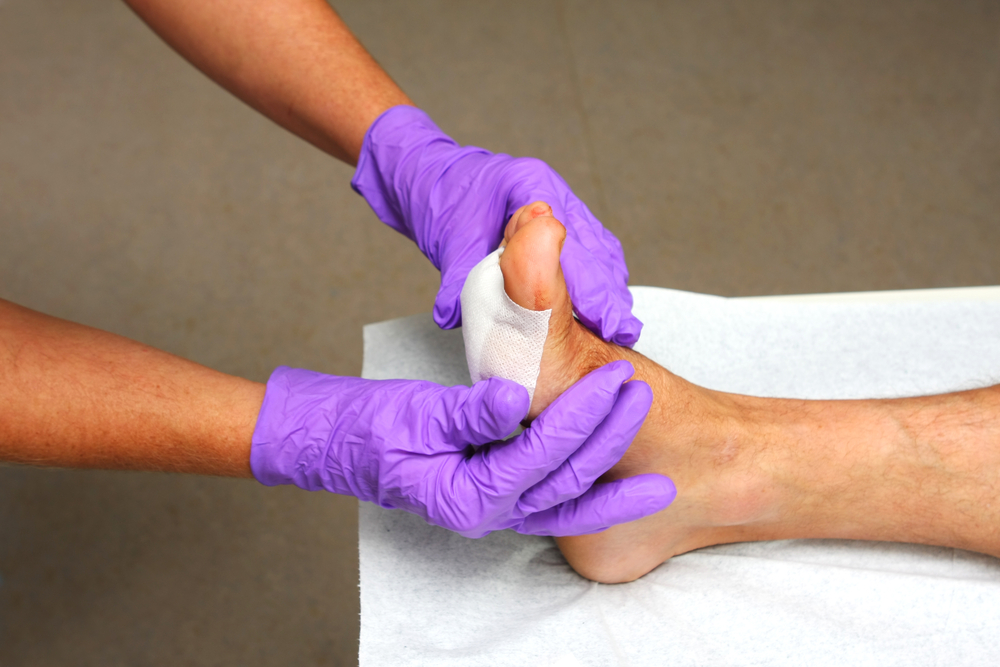 Research has shown the importance of taking care of your feet, and this is especially true if you are a diabetic patient. Many diabetic people have neuropathy, and this may cause a lack of feeling in the feet. Small cuts or bruises may go unnoticed as a result of this condition and may take longer to heal. Foot ulcers may affect up to twenty-five percent of diabetic patients, and it is important to properly take care of your feet. This can be accomplished by checking the feet daily, which may help you to notice any blisters, ingrown toenails, cuts or swelling that may exist. Additionally, the feet should be washed in lukewarm water on a daily basis, gently dried, and followed by using a good moisturizer. This may help to keep the skin soft, which may prevent dry skin. Wearing shoes that fit properly will help the overall health of the feet and choosing seamless socks may aid in preventing cuts in the skin. If you have diabetes, it is strongly suggested that you should seek the counsel of a podiatrist who can properly guide you in learning how to take care of diabetic feet.
Research has shown the importance of taking care of your feet, and this is especially true if you are a diabetic patient. Many diabetic people have neuropathy, and this may cause a lack of feeling in the feet. Small cuts or bruises may go unnoticed as a result of this condition and may take longer to heal. Foot ulcers may affect up to twenty-five percent of diabetic patients, and it is important to properly take care of your feet. This can be accomplished by checking the feet daily, which may help you to notice any blisters, ingrown toenails, cuts or swelling that may exist. Additionally, the feet should be washed in lukewarm water on a daily basis, gently dried, and followed by using a good moisturizer. This may help to keep the skin soft, which may prevent dry skin. Wearing shoes that fit properly will help the overall health of the feet and choosing seamless socks may aid in preventing cuts in the skin. If you have diabetes, it is strongly suggested that you should seek the counsel of a podiatrist who can properly guide you in learning how to take care of diabetic feet.
Diabetic foot care is important in preventing foot ailments such as ulcers. If you are suffering from diabetes or have any other concerns about your feet, contact Dr. Anna Petrov from Family Foot & Ankle Care. Our doctor can provide the care you need to keep you pain-free and on your feet.
Diabetic Foot Care
Diabetes affects millions of people every year. The condition can damage blood vessels in many parts of the body, especially the feet. Because of this, taking care of your feet is essential if you have diabetes, and having a podiatrist help monitor your foot health is highly recommended.
The Importance of Caring for Your Feet
- Routinely inspect your feet for bruises or sores.
- Wear socks that fit your feet comfortably.
- Wear comfortable shoes that provide adequate support.
Patients with diabetes should have their doctor monitor their blood levels, as blood sugar levels play such a huge role in diabetic care. Monitoring these levels on a regular basis is highly advised.
It is always best to inform your healthcare professional of any concerns you may have regarding your feet, especially for diabetic patients. Early treatment and routine foot examinations are keys to maintaining proper health, especially because severe complications can arise if proper treatment is not applied.
If you have any questions please feel free to contact one of our offices located in Wheeling and Chicago, IL . We offer the newest diagnostic and treatment technologies for all your foot and ankle needs.



